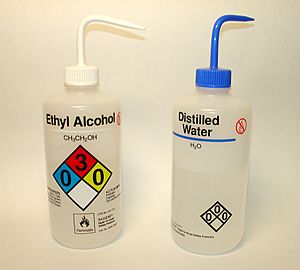Wash bottle facts for kids
A wash bottle is a squeeze bottle with a nozzle, used to rinse various pieces of laboratory glassware, such as test tubes and round bottom flasks.
Wash bottles are sealed with a screw-top lid. When hand pressure is applied to the bottle, the liquid inside becomes pressurized and is forced out of the nozzle into a narrow stream of liquid.
Most wash bottles are made up of polyethylene, which is a flexible solvent-resistant petroleum-based plastic. Most bottles contain an internal dip tube allowing upright use.
Wash bottles may be filled with a range of common laboratory solvents and reagents, according to the work to be undertaken. These include deionized water, detergent solutions and rinse solvents such as acetone, isopropanol or ethanol. In biological labs it is common to keep sodium hypochlorite solution in a wash bottle to disinfect unneeded cultures.
Contents
Colour codes on wash bottles
There are a consistent set of colour codes and markings used to identify the contents of wash bottles. Red is used for acetone, White for ethanol or sodium hypochlorite or distilled water, green for Methanol, yellow for isopropanol and blue for distilled water.
Safety
Safety warning labels are also used to identify potential hazards. Where reagents with high vapour pressure are used such as ethanol or methanol, small pressure release holes are incorporated into the cap to release and excess vapour pressure and avoid material being ejected through the nozzle when not in use.
Advantages
The use of wash bottles helps researchers control and measure the precise amount of liquid used. In addition, unwanted substances or particles cannot pass through wash bottles. The use of wash bottles is more convenient than using beaker and graduated cylinders.
Storage of Wash Bottles
Wash bottles are typically kept on the laboratory bench in a secure way so that they can be easily located and so that they do not interfere with other work taking place. Such containment may be by the use of two ring clamps which have similar size attached to a lattice rod.
Types
Different types of wash bottles are suitable with different types of substances. A spiral gas-lift wash bottle, for example, is suitable for eliminating gas with the liquid system having two phases like bromide and water. In addition, a Simple graduated wash bottle helps determine the amount of liquid used. A type of strong solvent and a type of destructive substance can be dealt with Nalgene Teflon FEP wash bottles since the special type of plastic is used to produce this type of wash bottles.
Gallery
See also
 In Spanish: Piseta para niños
In Spanish: Piseta para niños




